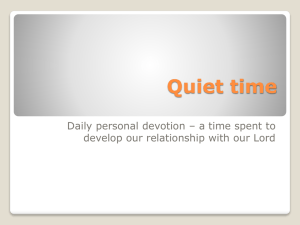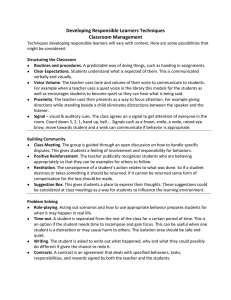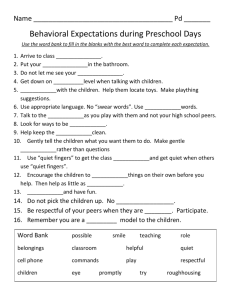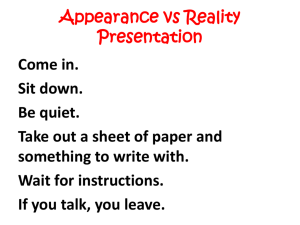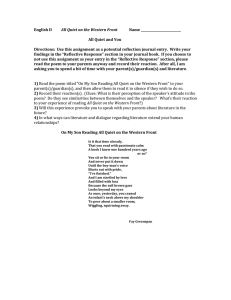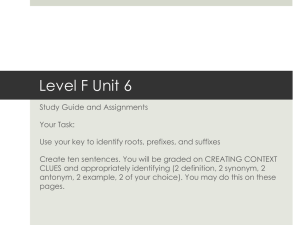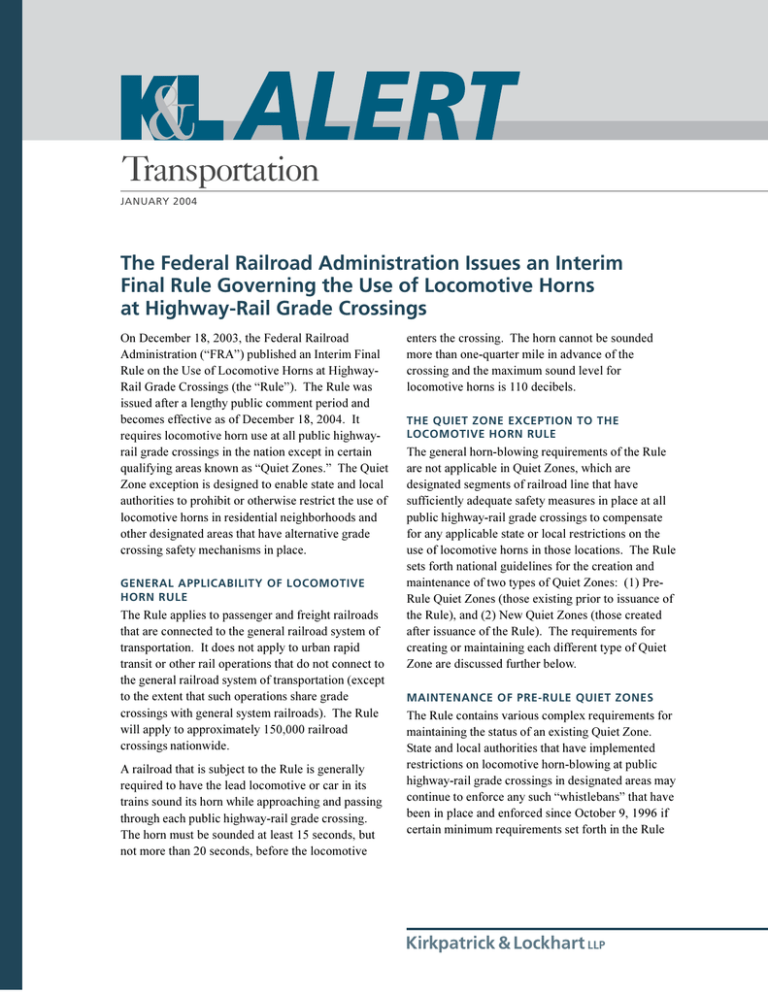
Transportation
JANUARY 2004
The Federal Railroad Administration Issues an Interim
Final Rule Governing the Use of Locomotive Horns
at Highway-Rail Grade Crossings
On December 18, 2003, the Federal Railroad
Administration (FRA) published an Interim Final
Rule on the Use of Locomotive Horns at HighwayRail Grade Crossings (the Rule). The Rule was
issued after a lengthy public comment period and
becomes effective as of December 18, 2004. It
requires locomotive horn use at all public highwayrail grade crossings in the nation except in certain
qualifying areas known as Quiet Zones. The Quiet
Zone exception is designed to enable state and local
authorities to prohibit or otherwise restrict the use of
locomotive horns in residential neighborhoods and
other designated areas that have alternative grade
crossing safety mechanisms in place.
GENERAL APPLICABILITY OF LOCOMOTIVE
HORN RULE
The Rule applies to passenger and freight railroads
that are connected to the general railroad system of
transportation. It does not apply to urban rapid
transit or other rail operations that do not connect to
the general railroad system of transportation (except
to the extent that such operations share grade
crossings with general system railroads). The Rule
will apply to approximately 150,000 railroad
crossings nationwide.
A railroad that is subject to the Rule is generally
required to have the lead locomotive or car in its
trains sound its horn while approaching and passing
through each public highway-rail grade crossing.
The horn must be sounded at least 15 seconds, but
not more than 20 seconds, before the locomotive
enters the crossing. The horn cannot be sounded
more than one-quarter mile in advance of the
crossing and the maximum sound level for
locomotive horns is 110 decibels.
THE QUIET ZONE EXCEPTION TO THE
LOCOMOTIVE HORN RULE
The general horn-blowing requirements of the Rule
are not applicable in Quiet Zones, which are
designated segments of railroad line that have
sufficiently adequate safety measures in place at all
public highway-rail grade crossings to compensate
for any applicable state or local restrictions on the
use of locomotive horns in those locations. The Rule
sets forth national guidelines for the creation and
maintenance of two types of Quiet Zones: (1) PreRule Quiet Zones (those existing prior to issuance of
the Rule), and (2) New Quiet Zones (those created
after issuance of the Rule). The requirements for
creating or maintaining each different type of Quiet
Zone are discussed further below.
MAINTENANCE OF PRE-RULE QUIET ZONES
The Rule contains various complex requirements for
maintaining the status of an existing Quiet Zone.
State and local authorities that have implemented
restrictions on locomotive horn-blowing at public
highway-rail grade crossings in designated areas may
continue to enforce any such whistlebans that have
been in place and enforced since October 9, 1996 if
certain minimum requirements set forth in the Rule
Kirkpatrick & Lockhart LLP
are met.1 These Pre-Rule Quiet Zones: (1) must
have the same length as the area covered by the
whistleban that existed as of October 9, 1996,
(2) must retain and cannot downgrade the warning
systems in place at their grade crossings, and
(3) must have advance-warning signs advising
motorists that locomotive horns are not sounded at
the crossings in that area.
A Pre-Rule Quiet Zone is subject to automatic FRA
approval if it complies with the three minimum
requirements set forth above and 1) has one or more
Supplementary Safety Measures (SSMs) such as a
four-quadrant gate system at every public crossing in
the area; 2) the Quiet Zone Risk Index2 is at or
below the Nationwide Significant Risk Threshold;3
or 3) the Quiet Zone Risk Index is above but not
more than twice the Nationwide Significant Risk
Threshold and there have been no relevant trainmotorist collisions at any of the public highway-rail
grade crossings within the area for the five years
preceding December 18, 2003.
If a Pre-Rule Quiet Zone does not meet at least one
of these three additional conditions required for
automatic approval, the governing state or local
authority may continue to enforce the whistleban
for an interim five-year period (until December 18,
2008) if within three years of issuance of the Rule
(by December 18, 2006) it submits an adequate plan
to the FRA for bringing the area into compliance
with the requirements for establishing a New Quiet
Zone. The addition of any new public highway-rail
grade crossing to a Pre-Rule Quiet Zone invalidates
the grandfathered status of that Quiet Zone, and the
deletion of any existing crossing must result in a
Quiet Zone of at least one-half mile in length in order
to preserve its Pre-Rule Quiet Zone status.
CREATION OF NEW QUIET ZONES
The Rule also contains various complex
requirements for creating New Quiet Zones. At a
minimum, a New Quiet Zone must be at least onehalf mile in length, must have active warning devices
that include both flashing lights and gates at every
crossing, and must have advance-warning signs
notifying motorists that train horns are not sounded
at the crossings in that area.
A New Quiet Zone will be subject to automatic FRA
approval (1) with the implementation of one or more
SSMs at every public crossing; (2) if the Quiet Zone
Risk Index is already at or below the Nationwide
Significant Risk Threshold without the
implementation of SSMs; (3) if implementation of
some SSMs reduces the Quiet Zone Risk Index
below the Nationwide Significant Risk Threshold; or
(4) if SSMs are implemented such that the Quiet
Zone Risk Index falls to a level at or below that level
which would exist were horns sounded at all
crossings within the Quiet Zone.
In the alternative, a public authority may apply to the
FRA for approval of a New Quiet Zone that does not
meet one of the four additional conditions required
for automatic approval. The application must
describe those Alternative Safety Measures
(ASMs) (or that combination of SSMs and ASMs)
that will be implemented. The FRA will approve the
application only if it determines that the proposed
safety measures would reduce the risk index in that
area to an acceptable level.4
SSMS AND ASMS
The FRA has established a clear preference for the
use of approved SSMs, which include physical
barriers such as four-quadrant gate systems as well
as safety procedures such as temporarily closing
1 Congress amended 49 U.S.C. § 20153, which requires the use of locomotive horns at public highway-rail grade
crossings but gives FRA the authority to make exceptions, on October 9, 1996. Therefore, Quiet Zones that were
established as of that date and that remain in place as of the date of issuance of the Rule are eligible for
grandfathering as Pre-Rule Quiet Zones.
2 The Quiet Zone Risk Index is a measure of risk to the motoring public at crossings within a particular Quiet Zone,
after adjustment for SSMs or Alternative Safety Measures (ASMs). The procedures for calculating the Quiet Zone
Risk Index are contained in Appendix D of the Rule. The FRA will review and recalculate the risk index applicable to
a particular Quiet Zone on an annual basis.
3 The Nationwide Significant Risk Threshold is a national average risk level for public highway-rail grade crossings
equipped with active warning devices.
4 A guide to the establishment of New Quiet Zones is found in Section II of Appendix C of the Rule.
Kirkpatrick & Lockhart LLP
2
crossings to highway traffic during designated quiet
periods.5 As described above, the use of SSMs
allows governing state and local authorities to
maintain Pre-Rule Quiet Zones or establish New
Quiet Zones without prior FRA approval.
ASMs typically are either modified SSMs or nonengineering ASMs such as public education and
awareness programs or photo enforcement
measures.6 The use of ASMs, which have not been
pre-approved by the FRA, may prevent governing
state and local authorities from obtaining automatic
FRA approval of a Quiet Zone unless the applicable
risk index in a particular area is lower than average.
PUBLIC COMMENT PERIOD
As the Rule is still an interim rule, the FRA has
allowed for an additional public comment period,
which runs through February 17, 2004. The FRA
has reserved the right to amend the Rule based on
any comments it receives during this period. It is
highly recommended that interested parties review
the provisions and the appendices to the Rule
carefully to determine their likely costs to maintain
compliance with the Rule. It is important for such
parties to take advantage of the additional comment
period in order to highlight or seek modification of
any potential problems in the Rule before it goes into
effect on December 18, 2004.
WAIVERS
KEVIN M. SHEYS
202.778.9290
ksheys@kl.com
Waivers of provisions of the Rule may be requested,
but must be jointly sought by the railroad owning or
controlling operations over the railroad tracks
crossing the public highway-rail grade crossing, and
the public authority that has jurisdiction over the
roadway crossing the railroad tracks. If the parties
cannot agree on a desired waiver, either may request
a waiver but must detail the efforts taken to reach an
agreement with the other party. The FRA will grant
the waiver if it is in the public interest and consistent
with highway and railroad safety.
EDWARD J. FISHMAN
202.778.9456
efishman@kl.com
BRENDON P. FOWLER
202.778.9237
bfowler@kl.com
5 The SSMs approved by the FRA are listed in Appendix A to the Rule.
6 Typical ASMs are listed in Appendix B to the Rule.
FOR FURTHER INFORMATION, please consult one of the lawyers listed below:
Boston
Harrisburg
Pittsburgh
Washington
Jeffrey S. King
Carleton O. Strouss
Theodore A. McConnell
Kevin M. Sheys
Edward J. Fishman
Tracie D. Spear
Janie C. I. Sheng
Brendon P. Fowler
617.261.3179
717.231.4503
412.355.6566
202.778.9290
202.778.9456
202.778.9390
202.778.9855
202.778.9237
jking@kl.com
cstrouss@kl.com
tmcconnell@kl.com
ksheys@kl.com
efishman@kl.com
tspear@kl.com
jsheng@kl.com
bfowler@kl.com
®
Kirkpatrick & Lockhart LLP
Challenge us.
®
www.kl.com
BOSTON
n
DALLAS
n
HARRISBURG
n
LOS ANGELES
n
MIAMI
n
NEWARK
n
NEW YORK
n
PITTSBURGH
n
SAN FRANCISCO
n
WASHINGTON
............................................................................................................................................................
This publication/newsletter is for informational purposes and does not contain or convey legal advice. The information herein
should not be used or relied upon in regard to any particular facts or circumstances without first consulting a lawyer.
© 2004 KIRKPATRICK & LOCKHART LLP.
ALL RIGHTS RESERVED.

